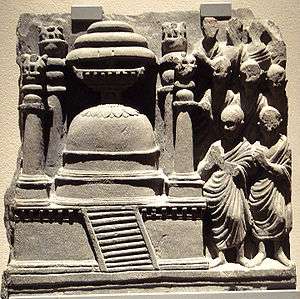Kanishka stupa

The Kanishka stupa was a monumental stupa established by the Kushan king Kanishka during the 2nd century CE in today's Shaji-ki-Dheri on the outskirts of Peshawar, Pakistan.
The stupa was described by Chinese pilgrims in the 7th century as the tallest stupa in all India.[1] Archaeologists have examined the remains of the structure and determined that it had a diameter of 286 feet. Ancient Chinese manuscripts tell of Buddhist pilgrims reporting that the stupa had a height of 591–689 feet. (The measurements they stated were in Chinese units, which were 600–700. This height was equal to about 180–210 meters or 591–689 feet.)
Three Chinese reports are known (by Faxian, who travelled between 399–412 CE, Sung Yun who arrived in India in 518 CE, Xuanzang who went to India in 630 CE). Sung Yun describes the stupa in the following terms:
- "The king proceeded to widen the foundation of the Great Tower 300 paces and more. To crown all, he placed a roof-pole upright and even. Throughout the building he used ornamental wood, he constructed stairs to lead to the top....there was an iron-pillar, 3-feet high with thirteen gilded circlets. Altogether the height from the ground was 700 feet.”
The stupa was discovered and excavated in 1908–1909 by a British archaeological mission under David Brainard Spooner, and led to the discovery in its base of the Kanishka casket, a six-sided rock crystal reliquary containing three small fragments of bone,[2] relics of the Buddha (which were transferred to Mandalay, Burma for safekeeping, where they still remain), and a dedication in Kharoshthi involving Kanishka.[3]
According to Buddhist the building of the stupa was foretold by the Buddha:
- "The Buddha, pointing to a small boy making a mud tope….[said] that on that spot Kanishka would erect a tope by his name." Vinaya sutra [4]
The same story is repeated in a Khotanese scroll found at Dunhuang, which first described how Kanishka would arrive 400 years after the death of the Buddha. The account also describes how Kanishka came to raise his stupa:
- "A desire thus arose in [Kanishka to build a vast stupa]….at that time the four world-regents learnt the mind of the king. So for his sake they took the form of young boys….[and] began a stupa of mud....the boys said to [Kanishka] ‘We are making the Kanishka-stupa.’….At that time the boys changed their form....[and] said to him, ‘Great king, by you according to the Buddha’s prophecy is a Sangharama to be built wholly (?) with a large stupa and hither relics must be invited which the meritorious good beings...will bring." [5]
Current status of the site
The site has not been preserved and is now a slum. The location was re-identified in 2011. It is located outside the Gunj Gate of the old Walled City of Peshawar and is called Akhunabad.[6]
Architecture

The plinth of this tower stupa had a square plan which was 272 feet wide if the stairs are included.[7] It had been suggested by Le Huu Phuothat it may have appeared similar to stupa A11 reliquary model from the Jaulian monastery. Hans Loeschner [8] suggests that it might have appeared similar to the stone relief from Butkara III in Swat valley with four pillars in the corners.
References
- ↑ King Kanishka's stupa was one of the wonders of the world, Video
- ↑ Spooner, D. B. (1908–9): "Excavations at Shāh-ji-Dherī." Archaeological Survey of India, p. 49.
- ↑ Marshall, John H. (1909): "Archaeological Exploration in India, 1908–9." (Section on: "The stūpa of Kanishka and relics of the Buddha"). Journal of the Royal Asiatic Society, 1909, pp. 1056–1061.
- ↑ Quoted in Kumar 91
- ↑ Quoted in Kumar 89
- ↑ Gandhara civilisation: Revered Buddhist site rediscovered near Peshawar, Manzoor Ali, August 27, 2011
- ↑ Buddhist Architecture by Le Huu Phuocp. 179
- ↑ The Stūpa of the Kushan Emperor Kanishka the Great, with Comments on the Azes Era and Kushan Chronology by Hans Loeschner
Further reading
- D’Ancona, Mirella Levi. (1949): "Is the Kaniṣka Reliquary a work from Mathurā?" Art Bulletin, Vol. 31, No. 4 (Dec., 1949), pp. 321–323.
- Dobbins, K. Walton. (1971): The Stūpa and Vihāra of Kanishka I. The Asiatic Society of Bengal Monograph Series, Vol. XVIII. Calcutta.
- Dobbins, K. Walton (1968): "Two Gandhāran Reliquaries." East and West, 18, 1968, pp. 151–165.
- Hargreaves, H. (1910–11): "Excavations at Shāh-jī-kī Ḍhērī." Archaeological Survey of India, pp. 25–32.
- Spooner, D. B. (1908-9): "Excavations at Shāh-ji-Dherī." Archaeological Survey of India, pp. 38–59.
Coordinates: 33°59′57″N 71°35′31″E / 33.99917°N 71.59194°E